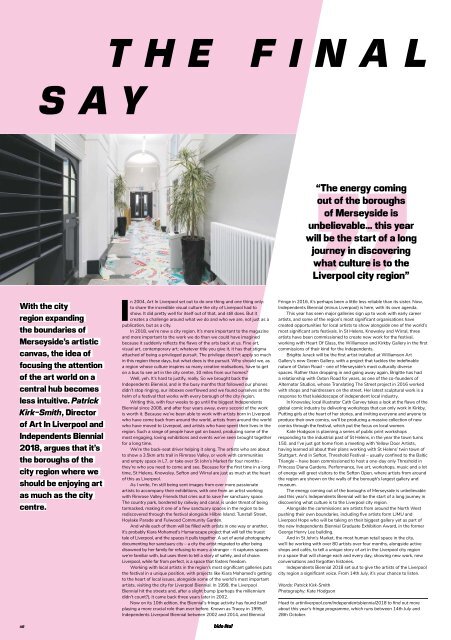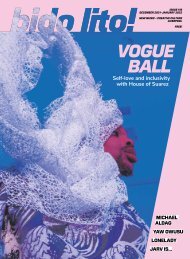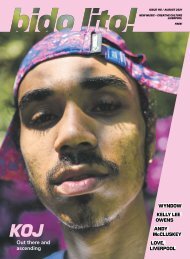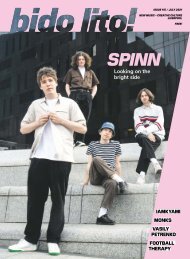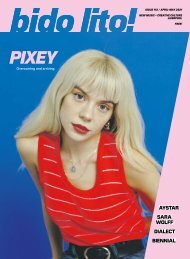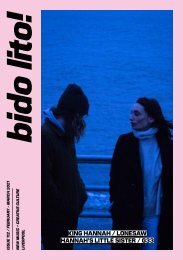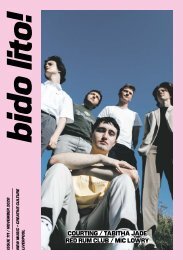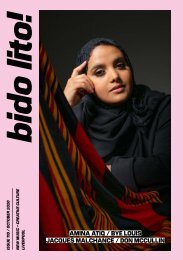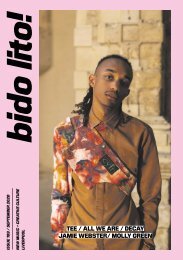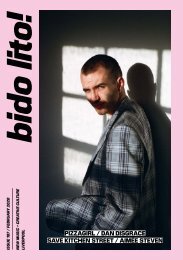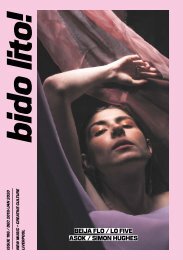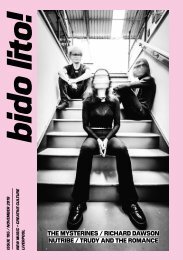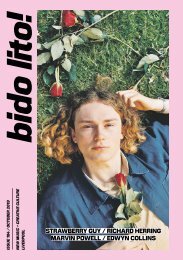Issue 90 / July 2018
July 2018 issue of Bido Lito! magazine. Featuring: MC NELSON, THE DSM IV, GRIME OF THE EARTH, EMEL MATHLOUTHI, REMY JUDE, LIVERPOOL BIENNIAL, CAR SEAT HEADREST, THE MYSTERINES, TATE @ 30 and much more.
July 2018 issue of Bido Lito! magazine. Featuring: MC NELSON, THE DSM IV, GRIME OF THE EARTH, EMEL MATHLOUTHI, REMY JUDE, LIVERPOOL BIENNIAL, CAR SEAT HEADREST, THE MYSTERINES, TATE @ 30 and much more.
Create successful ePaper yourself
Turn your PDF publications into a flip-book with our unique Google optimized e-Paper software.
SAY<br />
THE FINAL<br />
“The energy coming<br />
out of the boroughs<br />
of Merseyside is<br />
unbelievable… this year<br />
will be the start of a long<br />
journey in discovering<br />
what culture is to the<br />
Liverpool city region”<br />
With the city<br />
region expanding<br />
the boundaries of<br />
Merseyside’s artistic<br />
canvas, the idea of<br />
focusing the attention<br />
of the art world on a<br />
central hub becomes<br />
less intuitive. Patrick<br />
Kirk-Smith, Director<br />
of Art In Liverpool and<br />
Independents Biennial<br />
<strong>2018</strong>, argues that it’s<br />
the boroughs of the<br />
city region where we<br />
should be enjoying art<br />
as much as the city<br />
centre.<br />
In 2004, Art In Liverpool set out to do one thing and one thing only:<br />
to share the incredible visual culture the city of Liverpool had to<br />
show. It did pretty well for itself out of that, and still does. But it<br />
creates a challenge around what we do and who we are, not just as a<br />
publication, but as a city.<br />
In <strong>2018</strong>, we’re now a city region. It’s more important to the magazine<br />
and more important to the work we do than we could have imagined<br />
because it suddenly reflects the flaws of the arts back at us. Fine art,<br />
visual art, contemporary art; whatever title you give it, it has that stigma<br />
attached of being a privileged pursuit. The privilege doesn’t apply so much<br />
in this region these days, but what does is the pursuit. Why should we, as<br />
a region whose culture inspires so many creative realisations, have to get<br />
on a bus to see art in the city centre, 10 miles from our homes?<br />
Well, yeh. It’s hard to justify, really. So we brought back the<br />
Independents Biennial, and in the busy months that followed our phones<br />
didn’t stop ringing, our inboxes overflowed and we found ourselves at the<br />
helm of a festival that works with every borough of the city region.<br />
Writing this, with four weeks to go until the biggest Independents<br />
Biennial since 2008, and after four years away, every second of the work<br />
is worth it. Because we’ve been able to work with artists born in Liverpool<br />
who have come back from around the world, artists from around the world<br />
who have moved to Liverpool, and artists who have spent their lives in the<br />
region. Such a range of people have got on board, producing some of the<br />
most engaging, loving exhibitions and events we’ve seen brought together<br />
for a long time.<br />
We’re the back-seat driver helping it along. The artists who are about<br />
to show a 3.5km arts trail in Rimrose Valley, or work with communities<br />
and empty space in L7, or take over St John’s Market for four months –<br />
they’re who you need to come and see. Because for the first time in a long<br />
time, St Helens, Knowsley, Sefton and Wirral are just as much at the heart<br />
of this as Liverpool.<br />
As I write, I’m still being sent images from ever more passionate<br />
artists to accompany their exhibitions, with one from an artist working<br />
with Rimrose Valley Friends that cries out to save her sanctuary space.<br />
The country park, bordered by railway and canal, is under threat of being<br />
tarmacked, making it one of a few sanctuary spaces in the region to be<br />
rediscovered through the festival alongside Hilbre Island, Tunstall Street,<br />
Hoylake Parade and Fulwood Community Garden.<br />
And while each of them will be filled with artists in one way or another,<br />
it’s probably Kiara Mohamed’s Humanscape project that will tell the truest<br />
tale of Liverpool, and the spaces it pulls together. A set of aerial photography<br />
documenting her sanctuary city – a city the artist migrated to after being<br />
disowned by her family for refusing to marry a stranger – it captures spaces<br />
we’re familiar with, but uses them to tell a story of safety, and of choice.<br />
Liverpool, while far from perfect, is a space that fosters freedom.<br />
Working with local artists in the region’s most significant galleries puts<br />
the festival in a unique position, with projects like Kiara Mohamed’s getting<br />
to the heart of local issues, alongside some of the world’s most important<br />
artists, visiting the city for Liverpool Biennial. In 1999, the Liverpool<br />
Biennial hit the streets and, after a slight bump (perhaps the millennium<br />
didn’t count?), it came back three years later in 2002.<br />
Now on its 10th edition, the Biennial’s fringe activity has found itself<br />
playing a more crucial role than ever before. Known as Tracey in 1999,<br />
Independents Liverpool Biennial between 2002 and 2014, and Biennial<br />
Fringe in 2016, it’s perhaps been a little less reliable than its sister. Now,<br />
Independents Biennial (minus Liverpool) is here, with its own agenda.<br />
This year has seen major galleries sign up to work with early career<br />
artists, and some of the region’s most significant organisations have<br />
created opportunities for local artists to show alongside one of the world’s<br />
most significant arts festivals. In St Helens, Knowsley and Wirral, three<br />
artists have been commissioned to create new work for the festival,<br />
working with Heart Of Glass, the Williamson and Kirkby Gallery in the first<br />
commissions of their kind for the Independents.<br />
Brigitte Jurack will be the first artist installed at Williamson Art<br />
Gallery’s new Green Gallery, with a project that tackles the indefinable<br />
nature of Oxton Road – one of Merseyside’s most culturally diverse<br />
spaces. Rather than dropping in and going away again, Brigitte has had<br />
a relationship with Oxton Road for years, as one of the co-founders of<br />
Alternator Studios, whose Translating The Street project in 2016 worked<br />
with shops and hairdressers on the street. Her latest sculptural work is a<br />
response to that kaleidoscope of independent local industry.<br />
In Knowsley, local illustrator Cath Garvey takes a look at the flaws of the<br />
global comic industry by delivering workshops that can only work in Kirkby.<br />
Putting girls at the heart of her stories, and inviting everyone and anyone to<br />
produce their own comics, we’ll be producing a massive collection of new<br />
comics through the festival, which put the focus on local women.<br />
Kate Hodgson is planning a series of public print workshops<br />
responding to the industrial past of St Helens, in the year the town turns<br />
150, and I’ve just got home from a meeting with Yellow Door Artists,<br />
having learned all about their plans working with St Helens’ twin town of<br />
Stuttgart. And in Sefton, Threshold Festival – usually confined to the Baltic<br />
Triangle – have been commissioned to host a one-day only Threshold in<br />
Princess Diana Gardens. Performance, live art, workshops, music and a lot<br />
of energy will greet visitors to the Sefton Open, where artists from around<br />
the region are shown on the walls of the borough’s largest gallery and<br />
museum.<br />
The energy coming out of the boroughs of Merseyside is unbelievable<br />
and this year’s Independents Biennial will be the start of a long journey in<br />
discovering what culture is to the Liverpool city region.<br />
Alongside the commissions are artists from around the North West<br />
pushing their own boundaries, including five artists form LJMU and<br />
Liverpool Hope who will be taking on their biggest gallery yet as part of<br />
the new Independents Biennial Graduate Exhibition Award, in the former<br />
George Henry Lee building.<br />
And in St John’s Market, the most human retail space in the city,<br />
we’ll be working with over 80 artists over four months, alongside active<br />
shops and cafés, to tell a unique story of art in the Liverpool city region<br />
in a space that will change each and every day, showing new work, new<br />
conversations and forgotten histories.<br />
Independents Biennial <strong>2018</strong> set out to give the artists of the Liverpool<br />
city region a significant voice. From 14th <strong>July</strong>, it’s your chance to listen.<br />
Words: Patrick Kirk-Smith<br />
Photography: Kate Hodgson<br />
Head to artinliverpool.com/independentsbiennial<strong>2018</strong> to find out more<br />
about this year’s fringe programme, which runs between 14th <strong>July</strong> and<br />
28th October.<br />
46


